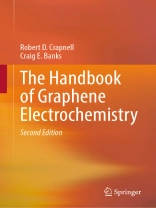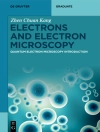This book charts the history of graphene, depicting how it has made an impact in the field of electrochemistry and how scientists are trying to unravel its unique properties. Graphene has grasped the attention of academia and industry worldwide due its unique structure and reported advantageous properties. This was reflected via the 2010 Nobel Prize in Physics being awarded for groundbreaking experiments regarding the two-dimensional material graphene. One particular area in which graphene has been extensively explored is electrochemistry where it is potentially the world’s thinnest electrode material. Graphene has been widely reported to perform beneficially over existing electrode materials when used within energy production or storage devices and when utilized to fabricate electrochemical sensors.
A fundamental introduction into Graphene Electrochemistry is given, through which readers can acquire the tools required to effectively explain and interpret the vast array of graphene literature. The readers are provided with the appropriate insights required to be able to design and implement electrochemical experiments when utilizing graphene as an electrode material. This new, updated and extended second edition also explores other 2D materials and covers a chapter on the use of graphene in additive manufacturing.
Daftar Isi
1. Introduction to graphene.- 2. Interpreting electrochemistry.- 3 The electrochemistry of graphene.- 4 Graphene applications.- 5. Graphene Additive Manufacturing.- Appendix.
Tentang Penulis
Robert D. Crapnell is a senior research associate at The Manchester Metropolitan University, Manchester, UK. Robert completed his Ph D in electrochemistry at The University of Hull in 2018 and has since published >75 research papers. His research interests lie in the use of nanomaterials, such as graphene, to produce new conductive materials and their subsequent use as electrochemical platforms through various techniques including additive manufacturing.
Craig E. Banks holds a Personal Chair at Manchester Metropolitan University and has published more than 600 papers, 4 books, 20 book chapters and is the lead inventor on 21 patents. Craig has spun out 2 companies from his research and was awarded the Royal Society of Chemistry’s Harrison–Meldola Memorial Prize (2011) for his contributions to the understanding of carbon materials, in particular graphene and its application as an electrode material, was awarded a Royal Society of Chemistry Tilden Prize (2023) Winner, awarded for outstanding contributions to electrochemistry through pioneering additive manufacturing and also the Royal Society of Chemistry L. S. Theobald Lectureship (2024) who has demonstrated a significant contribution to the development or application of analytical chemistry. Craig is known for both his fundamental and applied aspects of electrochemistry, with the significant development of next generation screen-printing electrodes and more recently the use of additive manufacturing.












